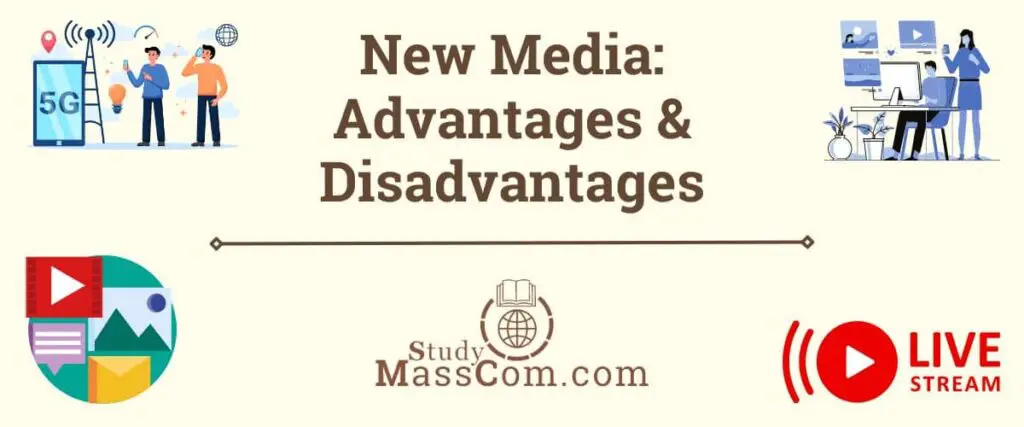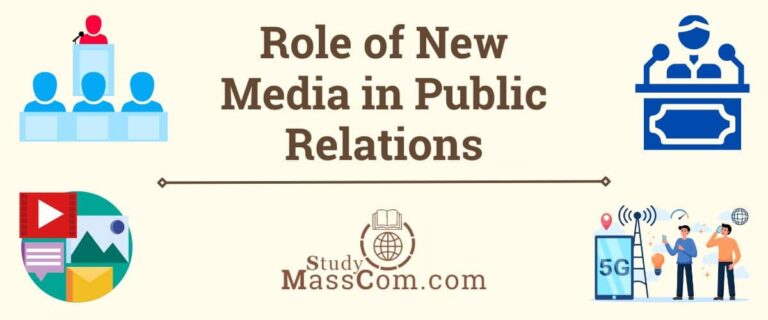Advantages and Disadvantages of New Media
In the digital age, the landscape of media has undergone a significant transformation, giving rise to what we know as “new media.” This paradigm shift has revolutionized the way information is disseminated, consumed, and shared. New media encompasses a wide range of platforms, including social media, blogs, podcasts, streaming services, and more, each presenting unique advantages and disadvantages. In this SEO-optimized article, we will explore the diverse aspects of new media, highlighting its benefits and drawbacks in a world increasingly reliant on technological innovations.

Advantages of New Media
Global Reach and Accessibility
One of the most significant advantages of new media is its ability to reach a vast global audience instantly. The internet has bridged geographical barriers, allowing content creators and businesses to engage with users worldwide. This global accessibility enhances the reach of information, products, and services, enabling small businesses and individuals to compete on a level playing field with larger enterprises.
Cost-Effectiveness
Compared to traditional media channels like television and print, new media platforms offer cost-effective solutions for content distribution. Setting up a website, starting a blog, or creating social media accounts requires minimal investment, making it accessible to startups and individuals with limited budgets. Additionally, targeted online advertising allows businesses to optimize their marketing expenditures and reach the right audience.
Interactivity and Engagement
New media thrives on interactivity, promoting two-way communication between content creators and consumers. Social media platforms, in particular, facilitate real-time interactions and feedback, fostering a sense of community around brands and content. This high level of engagement allows businesses to understand customer preferences better, resulting in more personalized offerings and improved customer satisfaction.
Real-Time Updates
Traditional media often struggles to keep pace with rapidly evolving events. New media, on the other hand, excels in delivering real-time updates on news, trends, and developments. This instant access to information empowers individuals to stay informed, make quick decisions, and participate in discussions that matter to them.
Data Analytics and Insights
New media platforms provide invaluable data analytics and insights, enabling content creators and businesses to measure the performance of their campaigns accurately. By analyzing user behavior, preferences, and engagement metrics, organizations can refine their strategies, tailor content, and optimize user experiences.
Disadvantages of New Media
Information Overload and Credibility Issues
With the abundance of content available on new media platforms, users often face information overload. Differentiating between credible and unreliable sources becomes challenging, leading to the spread of misinformation and fake news. Additionally, malicious actors may exploit new media to disseminate misleading or harmful content, compromising the credibility of the entire medium.
Privacy and Security Concerns
As new media thrives on data collection and user interactions, privacy and security concerns have become paramount. Instances of data breaches, hacking, and unauthorized access to personal information have raised questions about the safety of online platforms. Users must be cautious about sharing sensitive data, while content creators and businesses must prioritize data protection to maintain trust with their audiences.
Short Attention Spans
The fast-paced nature of new media can lead to shortened attention spans among users. With an endless stream of content available at their fingertips, individuals may quickly move on to the next piece of information, making it challenging for creators to capture and retain their audience’s interest for extended periods.
Digital Divide
While new media has revolutionized connectivity, it has also exacerbated the digital divide. Not everyone has equal access to high-speed internet and the latest technology, limiting their participation in the digital world. This divide can perpetuate existing inequalities and restrict opportunities for socio-economic advancement.
Explore the difference between traditional media and new media.
Ephemeral Content and Content Saturation
New media platforms often prioritize the display of real-time and ephemeral content, leading to a sense of content saturation. Content creators must compete for visibility, potentially compromising the quality and depth of their work to garner immediate attention.
Conclusion
New media has become an integral part of modern society, revolutionizing how we access and share information. Its advantages, including global reach, interactivity, and cost-effectiveness, have empowered businesses and individuals alike. However, its disadvantages, such as information overload and privacy concerns, necessitate a cautious approach to its usage. As we navigate the ever-changing landscape of new media, striking a balance between its advantages and disadvantages will be critical to harness its potential for a better-informed and connected world.
FAQs
New media refers to a broad range of digital technologies and platforms that have emerged in the Information Age. It encompasses various forms of online communication, such as social media, blogs, podcasts, online videos, streaming services, and more. Unlike traditional media, new media relies on the internet and digital technology to facilitate instant information dissemination, interactivity, and user participation.
The importance of new media lies in its transformative impact on communication, information sharing, and connectivity. It has revolutionized how people access and consume content, breaking down geographical barriers and enabling global interactions. New media has democratized information dissemination, allowing individuals and small businesses to have a voice and reach a wide audience without the need for significant financial investments.
Moreover, new media’s interactivity fosters real-time engagement between content creators and consumers, creating dynamic online communities. This level of engagement provides valuable insights for businesses and organizations, leading to more personalized offerings and improved customer satisfaction.
In essence, new media plays a pivotal role in shaping modern society, facilitating the flow of information, promoting connectivity, and empowering individuals and businesses to thrive in the digital era.
The scope of new media is vast and continuously evolving as digital technology advances. It encompasses a wide range of platforms and technologies that facilitate communication, information sharing, and entertainment in the digital age. Key components of new media include social media platforms, blogs, vlogs, podcasts, streaming services, online news outlets, digital advertising, virtual and augmented reality, and more.
The scope of new media extends across various sectors, including journalism, marketing, entertainment, education, and social interactions. It has revolutionized how news is disseminated, how products and services are marketed, and how people connect and engage with each other globally.
With the ever-increasing accessibility of the internet and the rapid development of digital tools, the scope of new media is expected to continue expanding. As technology evolves, new opportunities and challenges will emerge, further shaping the way we communicate, consume content, and interact in the digital landscape.
The benefits of new media include its global reach and accessibility, cost-effectiveness, interactivity and engagement, real-time updates, and data analytics. It empowers businesses and individuals to connect with a vast audience instantly, allowing for targeted marketing and personalized content. The interactive nature of new media fosters two-way communication, building communities around brands and content creators. Moreover, real-time updates enable users to stay informed on the latest news and trends. Data analytics provide valuable insights, allowing organizations to refine strategies and optimize user experiences.
New media offers several advantages to students, transforming the way they learn and interact with educational content:
1. Access to a wealth of information: With new media, students have access to a vast repository of educational resources, including online textbooks, academic articles, video lectures, and interactive learning platforms, enabling them to explore various topics beyond traditional classroom materials.
2. Enhanced learning experiences: Interactive and multimedia-rich content on new media platforms can make learning more engaging and enjoyable for students. Educational videos, simulations, and gamified learning applications can help reinforce concepts and improve comprehension.
3. Flexibility and convenience: New media allows students to access educational content anytime and anywhere, accommodating different learning styles and schedules. They can study at their own pace, which is particularly beneficial for self-paced or distance learning programs.
4. Collaboration and networking: Online platforms enable students to collaborate with peers from different locations, facilitating knowledge exchange and group projects. Social media and forums provide opportunities to connect with experts and educators for additional guidance.
5. Personalized learning paths: New media platforms can use data analytics to track student progress and preferences, enabling personalized learning paths and targeted support, and enhancing the overall learning experience.
6. Accessible assistive technologies: New media can incorporate assistive technologies that cater to students with disabilities, making educational content more inclusive and accessible to all learners.
Overall, new media empowers students to take charge of their education, fostering a more dynamic and interactive learning environment that adapts to their individual needs and preferences.


Good note especially for us students.